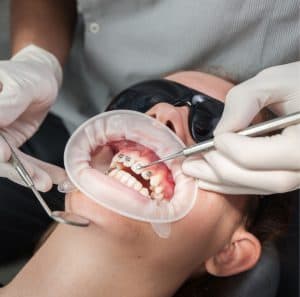
Today’s the day! What should you expect? A little knowledge goes a long way!
How Braces are Put On Your Teeth
- Brush your teeth well and floss at home. Have a picture taken. That crooked smile is going to change!
- Apply a thick coat of Chapstick or lip balm to your lips, because they tend to get rather dry during the process of installing the braces.
- The dental assistant or orthodontist will dry off your teeth and apply “etchant” to them. This tastes like Krazy Glue and is vile. Try not to get it on your tongue. The etchant prepares the surface of your teeth for the bonding “cement” that holds on the brackets.
- The brackets are placed on your teeth. A high intensity plasma light is then quickly applied to the surface of the bracket to set the bond.
- The wire (arch wire) is placed through the brackets. This should not poke your cheek. If it does, tell them so that the end of the wire can be clipped.
- Little ligating modules, (also known as ligatures or o-rings) are placed on the brackets. This is what holds the wire to them and creates a feeling of pressure. If you get Damon Brackets, the ligatures are not necessary.
- That’s it! You’re done! Each row of teeth takes about an hour, so if you’re getting a full set of braces, it will take about two hours. It doesn’t hurt, and you don’t need to get any shots. But you will probably be tired of having your mouth propped open for so long!
What Does It Feel Like To Get Dental Braces?
- At first, you will feel an unusual feeling of pressure on your teeth. If any of your teeth have metal brackets around them, this will feel weird, but not unbearable.
- At first, feeling the braces underneath your lips will be a strange sensation. After about a week, you’ll probably find that you barely notice it.
- You should stick to soft foods for the first day or two; nothing crunchy or hard, nothing large and difficult to chew (e.g., big sub sandwiches or burritos).
- The first day, it may not hurt too much. The second and third days, it may feel like somebody hit you in the teeth with a baseball. Take a pain reliever like Ibuprofen (Motrin/Advil) or acetaminophen (Tylenol) and try to chill out. It will get better!
- At first you will not be able to eat certain foods, like tortilla chips, sugar cones, crunchy cookies, hard taco shells, etc. When you eat out, think of your teeth first and be kind to yourself! Order soft foods!
- Chewing will be difficult. You may gnash the insides of your cheeks. The metal hooks on the brackets may hurt. Just chew slowly and carefully. Do not take large mouthfuls. Hint: Fill up on protein-rich foods, not just carbs, so you can go several hours between meals!
- At first, you won’t be used to food getting lodged in your braces. This really takes some time to get used to. It doesn’t hurt, it just feels weird and make you want to run immediately to the bathroom to rinse and brush. In time it won’t bother you as much.
- Use dental wax on the little hooks or brackets that hurt. You may not need to use the wax for long, maybe just a week or two until your mouth adjusts to all the hardware. Just break off a piece of wax and gob it on the offending area.
- Don’t try to floss for several days, or even a week. It will probably hurt too much.
- After a week or two, your teeth may feel loose. That’s normal and necessary. It passes in another week or two.
- Your bite will change as time passes. After a few months, your bite may seem “off.” This is normal and will be corrected by the time your treatment is finished.
You may develop gaps between teeth that you didn’t have previously. Don’t worry, they will go away before your treatment is finished.
What the Heck Can I Eat With Braces?
In the “old days,” dentists had a long list of foods to avoid. Well, you’re not a kid and you’re probably not going to be eating jaw breakers, gummi bears, or anything stupid. You can eat anything that seems sensible and “do-able.”
Tip: Nuts get stuck in your teeth and are painful, so avoid them at first.
Here’s a short list of my favorites for those painful first days (or the days after an adjustment). For a longer list, go here. Also, there are several soft food cookbooks available for people with braces!
- Meatloaf or meatballs
- Tuna, chicken, or egg salad
- Lunch meat (plain, not in a sandwich — sandwiches can be too hard to chew)
- Soup
- Cheese slices
- Cooked eggs
- French toast, pancakes, waffles
- Soft cooked meat (pot roast, roasted chicken, etc)
- Baked or broiled fish
- Non-crusty bread without seeds or chunks
- Saltine crackers (they crumble on the roof of your mouth!)
- Cottage cheese
- Yogurt (custard-type is best; the less chunks the better — or just don’t eat the fruit chunks!)
- Cereal that gets soggy in milk
- Oatmeal or hot cereals
- Ice cream and cake (hey, what the hell, treat yourself! But remember, no nuts!)
- Frozen cheese blintzes or potato pancakes
Next….Living with Braces

